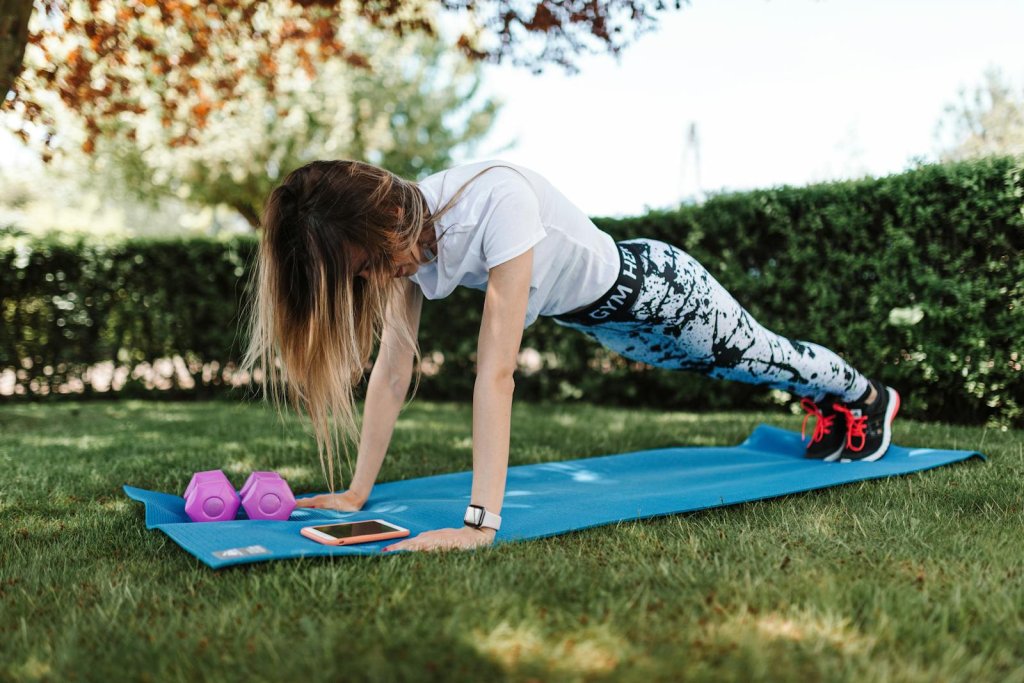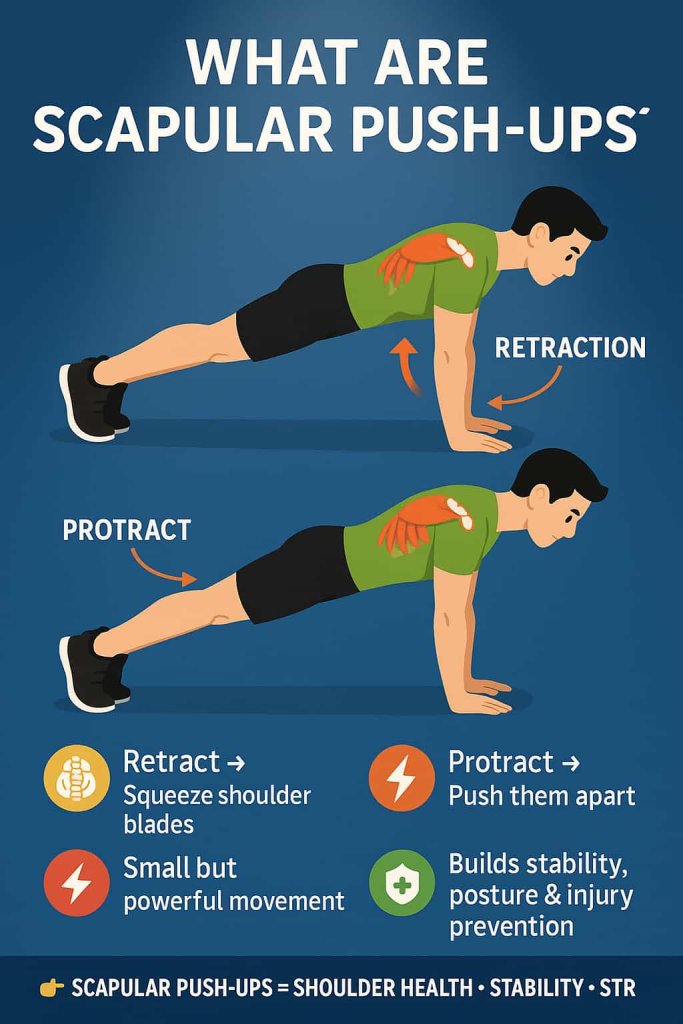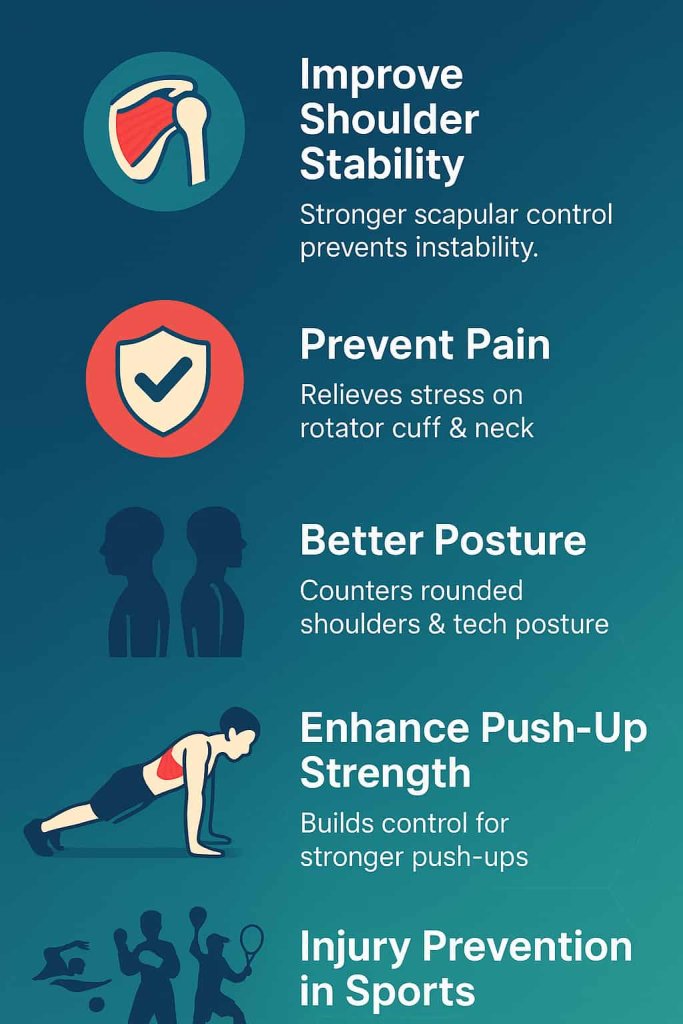Yes — scapular push-ups are one of the best exercises to build shoulder stability and prevent pain.
This simple but powerful move strengthens the serratus anterior and supporting muscles around the shoulder blade, helping you avoid common issues like impingement, poor posture, and nagging shoulder pain.

Understanding how scapular push-ups work is essential because the exercise not only improves shoulder mechanics but also enhances push-up form, posture, and athletic performance. Whether you’re a beginner, an athlete, or recovering from injury, you can adapt this exercise with easy progressions.
In this guide, we’ll cover benefits, proper form, step-by-step instructions, progressions, and FAQs so you can safely add scapular push-ups to your training routine.
What Are Scapular Push-Ups?
Scapular push-ups are a variation of the classic push-up designed to train the shoulder blades (scapulae) instead of the arms.

- You start in a push-up position.
- Without bending your elbows, you squeeze your shoulder blades together (retraction) and then push them apart (protraction).
- The movement is small but powerful, isolating the muscles that control the scapula.
👉 Scapular push-ups are often used in physical therapy, athlete warm-ups, and posture correction programs because of their rehabilitative and preventive benefits.
Muscles Worked in Scapular Push-Ups
Scapular push-ups mainly target stabilizers rather than big movers:
- Primary: Serratus anterior
- Secondary: Rhomboids, lower trapezius, levator scapulae, pectoralis minor, core stabilizers
Together, these muscles keep your shoulders aligned, improve posture, and reduce injury risk.
How to Do Scapular Push-Ups (Step-by-Step)
Follow these step-by-step instructions for correct technique:
- Set Up in a High Plank → Hands under shoulders, arms locked, spine neutral, and core tight.
- Retract Shoulder Blades → Slowly pinch your shoulder blades together.
- Protract Shoulder Blades → Push the floor away, spreading the shoulder blades apart.
- Stay Controlled → Movement should be slow and deliberate — no jerking.
- Reps & Sets → Perform 10–15 reps for 2–3 sets.
👉 Trainer Tip: Focus on scapular movement — your elbows must stay straight throughout the exercise.
Common Mistakes to Avoid
Many beginners make errors that reduce the effectiveness of scapular push-ups:
- Bending the elbows → This turns it into a regular push-up.
- Shrugging shoulders → Avoid letting them rise toward your ears.
- Sagging hips or arching back → Keep your core engaged.
- Moving too fast → Rushing reduces muscle activation.
Correcting these mistakes ensures maximum benefit and prevents strain.
Benefits of Scapular Push-Ups
According to physiotherapists and strength coaches, scapular push-ups deliver unique benefits beyond standard push-ups:

- Improve Shoulder Stability → Strong scapular control reduces dislocations, impingement, and instability.
- Prevent Pain → Relieves stress on the rotator cuff and neck muscles.
- Better Posture → Counters rounded shoulders from desk work and phone use.
- Enhance Push-Up Strength → Builds control for stronger, safer push-ups.
- Injury Prevention in Sports → Beneficial for swimmers, boxers, tennis players, and weightlifters.
Progressions & Variations of Scapular Push-Ups
Scapular push-ups can be adapted to suit beginners, intermediate lifters, advanced athletes, and even those in rehab. The goal is to progressively challenge the scapular stabilizers without compromising form. Here’s how you can scale the movement:
🟢 Beginner Progressions
- Wall Scapular Push-Ups → Stand facing a wall, place hands at shoulder height, and perform the same protraction–retraction motion while keeping your body straight.
Why it works: Reduces load on the shoulders and core, making it easy to learn proper movement mechanics.
- Kneeling Scapular Push-Ups → Perform the exercise on your knees instead of toes, lowering the intensity but still engaging the scapula and serratus anterior.
Trainer Tip: Keep hips tucked and core braced—avoid collapsing your lower back.
🟡 Intermediate Variations
- Incline Scapular Push-Ups → Place hands on a sturdy bench, box, or elevated surface. This slightly increases resistance compared to wall push-ups but remains easier than floor level.
Why it works: Adds moderate load while still being beginner-friendly, great for building endurance and control.
- Slow Eccentric Focus → Perform the retraction phase very slowly (3–5 seconds), then push explosively into protraction.
Trainer Tip: Time under tension builds stability and muscular endurance.
🔴 Advanced Variations
- Band-Resisted Scapular Push-Ups → Anchor a resistance band around your upper back and hold the ends under your palms. Perform the same scapular movement with added resistance.
Why it works: Increases strength and hypertrophy of the scapular stabilizers, ideal for athletes and advanced lifters.
- Weighted Scapular Push-Ups → Place a weight plate or wear a weighted vest while performing the exercise.
Trainer Tip: Start with light load (5–10 lbs) to avoid compromising scapular mechanics.
How Often Should You Do Scapular Push-Ups?
- General fitness: 2–3 times per week as part of warm-up.
- Rehabilitation: Daily or every other day with low volume (under guidance of a therapist).
- Athletes: Incorporate 3–4 sets in warm-ups before upper-body training.
Who Should Do Scapular Push-Ups?
- Office workers with rounded shoulders or neck tension.
- Athletes requiring shoulder stability (swimming, tennis, boxing).
- Lifters who want stronger bench press or overhead strength.
- Anyone recovering from mild shoulder instability (with medical clearance).
When to Avoid Scapular Push-Ups
Skip or modify scapular push-ups if:
- You have acute shoulder injuries (rotator cuff tear, severe impingement).
- You feel sharp pain during the movement.
- Your doctor or physiotherapist restricts shoulder activity.
FAQs: Scapular Push-Ups
1. What are scapular push-ups good for?
They strengthen stabilizers, improve posture, and prevent shoulder injuries.
2. Do scapular push-ups build muscle size?
No, they mainly train stabilizers like the serratus anterior. They’re for control and health, not bulk.
3. Are scapular push-ups safe for beginners?
Yes — wall or kneeling versions are perfect for beginners.
4. How many scapular push-ups should I do daily?
Start with 10–15 reps for 2–3 sets, focusing on slow, controlled movement.
5. Do scapular push-ups improve posture?
Yes — they strengthen the muscles that keep shoulders back and aligned.
6. Can they replace push-ups?
No — they complement push-ups by training stability, not pressing strength.
7. Do scapular push-ups help prevent injury?
Yes, especially for overhead athletes and lifters.
Conclusion
Scapular push-ups may look simple, but they’re one of the most powerful exercises for shoulder health. By targeting the serratus anterior and other stabilizers, they build a foundation of stability, prevent pain, and improve posture.
👉 Add them to your warm-up, mobility, or rehab routine, and you’ll notice stronger, healthier shoulders over time.
